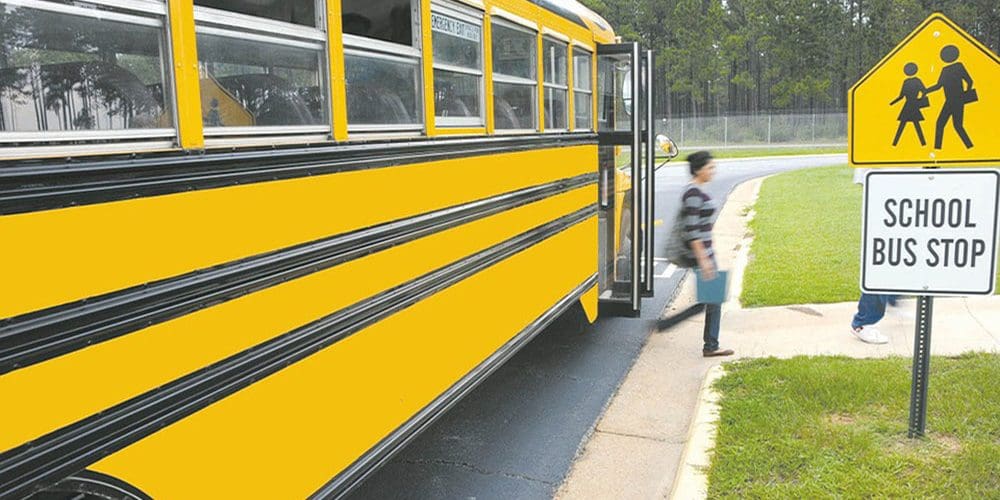Lack of Requirements, Background Checks for School Bus Drivers Endangers Student Safety
An investigative report by CBS points to “lack of oversight” of criminal charges of school bus drivers, including DUI’s and possession of child porn.

On average, 60 school bus accidents happen each day in the United States, amounting to around 22,000 school bus accidents per year.
Requirements for school bus drivers vary from state to state, sometimes resulting in lackadaisical and inconsistent hiring and tracking processes.
The minimum requirement for becoming a school bus driver is having a high school diploma and a Commercial Drivers License (CDL). Many federal rules that apply to a CDL holder, however, do not apply to most school bus drivers because they don’t cross state lines often, reports CBS News.
For instance, a motorist who maintains a CDL and crosses state lines cannot have any potentially inhibiting medical conditions. School bus drivers who do not cross state lines are often excluded from this requirement.
“Truck drivers that are driving heads of lettuce or television sets actually have to meet higher safety standards than the people that drive our children on school buses,” says transportation attorney Steve Gursten.
Only two states, Connecticut and Delaware, keep track of all school bus driver arrests on the job, according to CBS.
CBS reports that 21 states claimed no school bus drivers had been charged with a DUI in the last three years, but the network discovered at least one DUI arrest in each of the 21 states.
“Parents assume when they put their children on a school bus that that driver is safe. These parents really need to be asking who’s driving their children,” reiterates Gursten.
The investigation found that least once a week on average, a school bus driver is arrested for a DUI, child porn, or sexually assaulting a student.
Renaldo Vega, a former school bus driver for the East Irondequoit School District in New York, was charged in 2014 with three counts of forcible touching and endangering the welfare of a child. Charges were later dropped but Vega pleaded guilty to assault.
The victim’s family says their daughter was 15-years-old at the time and has special needs.
Vega had previously been arrested in 2013 on suspicion of child abuse.
Adding to the problem is a lack of school bus drivers, an issue reported by 90 percent of school districts in 2016. One of the largest school bus companies in the country, Durham School Services, is resorting to hiring from Craigslist.
Durham School Services hired Kelly Shane Hooper from Craigslist in 2015 as a school bus driver for Topeka Unified School District 501. He was facing child pornography charges in Texas and was a fugitive at the time of his hire. Hooper was found guilty in 2016 on five counts of possession of child pornography.
Other districts, like Wayne County in North Carolina, are recruiting internal employees such as janitors and cafeteria workers to drive school buses. Sixteen workers participated in a three-day CDL training course last week.
In response to this article, we received a detailed comment from Charlie Hood, Executive Director of the National Association of State Directors of Pupil Transportation Services (NASDPTS), in which he provided statistics and evidence that refute some of the claims from CBS’s investigative report. The comment read as follows:
The CBS report on June 27, 2017, is disturbing to those of us among the one half million student transportation safety professionals in the US, especially the nation’s estimated 480,000 professional school bus drivers. No responsible school bus driver ever wants to see a child’s physical safety or emotional security endangered in any way. In addition to the unacceptable and heinous actions of a few current or former school bus drivers, however, the other very concerning aspect of the CBS report is that it was so incomplete and inaccurate in its portrayal of the overall safety afforded to the nation’s school bus riders.
Many states have stringent requirements for licensure, training, and qualifications of school bus drivers in place that well exceed the federal requirements for possession of a valid commercial driver license and the not-mentioned random drug and alcohol testing that is also required federally for school bus drivers. State and local requirements frequently include extensive pre-service and in-service training, periodic checks for criminal background (as with other school employees who have contact with children), medical fitness examinations identical to those required by the federal government (including those lettuce truck drivers mentioned by CBS), and scheduled checks or real time reporting of driving records for DUIs and other less serious violations to provide accountability for driving performance.
CBS failed to report any of these facts, nor did they report the most important fact of which parents should be aware when deciding how their children get to and from school. School buses are many times safer than the other ways students get to and from school. The National Highway Traffic Safety Administration, the agency charged with promulgating federal motor vehicle safety standards, has adopted over 37 safety standards that apply to school buses. According to NHTSA, from 2005 through 2013 less than one percent of the fatalities to school children in traffic crashes during school travel hours were in a school bus, compared to 23 percent in adult-driven smaller passenger vehicles, and 57 percent in vehicles driven by teens. This unparalleled safety record is due to the professional qualifications and performance of nearly all school bus driving professionals, in combination with the purpose-built vehicle safety of school buses themselves.
Because school bus transportation is so safe, CBS has done a disservice to parents who may, as a result of the network’s misleading and incomplete reporting, make the choice not to allow their students to ride the bus. That decision is simply the wrong one. Motor vehicle crashes are the number one hazard faced by school age children, and they are far less safe getting to school when they do not ride the bus. As in any profession, we regret that there are some bad actors like those in the CBS report. As professionals entrusted to safely transport America’s school students, we do whatever we can to weed out individuals who should never be allowed to drive school buses or have contact with children. When it comes to student safety, there is no tolerance for error, and we welcome any reasonable measures to make students even safer than they already are in and around school buses.
Should Campus Safety Magazine or any of its readers be interested in more information, I can be reached at ExecDir@nasdpts.org. Thank you for allowing me this opportunity to comment on the article.
If you appreciated this article and want to receive more valuable industry content like this, click here to sign up for our FREE digital newsletters!
 Leading in Turbulent Times: Effective Campus Public Safety Leadership for the 21st Century
Leading in Turbulent Times: Effective Campus Public Safety Leadership for the 21st Century
This new webcast will discuss how campus public safety leaders can effectively incorporate Clery Act, Title IX, customer service, “helicopter” parents, emergency notification, town-gown relationships, brand management, Greek Life, student recruitment, faculty, and more into their roles and develop the necessary skills to successfully lead their departments. Register today to attend this free webcast!















The CBS report on June 27, 2017, is disturbing to those of us among the one half million student transportation safety professionals in the US, especially the nation’s estimated 480,000 professional school bus drivers. No responsible school bus driver ever wants to see a child’s physical safety or emotional security endangered in any way. In addition to the unacceptable and heinous actions of a few current or former school bus drivers, however, the other very concerning aspect of the CBS report is that it was so incomplete and inaccurate in its portrayal of the overall safety afforded to the nation’s school bus riders.
Many states have stringent requirements for licensure, training, and qualifications of school bus drivers in place that well exceed the federal requirements for possession of a valid commercial driver license and the not-mentioned random drug and alcohol testing that is also required federally for school bus drivers. State and local requirements frequently include extensive pre-service and in-service training, periodic checks for criminal background (as with other school employees who have contact with children), medical fitness examinations identical to those required by the federal government (including those lettuce truck drivers mentioned by CBS), and scheduled checks or real time reporting of driving records for DUIs and other less serious violations to provide accountability for driving performance.
CBS failed to report any of these facts, nor did they report the most important fact of which parents should be aware when deciding how their children get to and from school. School buses are many times safer than the other ways students get to and from school. The National Highway Traffic Safety Administration, the agency charged with promulgating federal motor vehicle safety standards, has adopted over 37 safety standards that apply to school buses. According to NHTSA, from 2005 through 2013 less than one percent of the fatalities to school children in traffic crashes during school travel hours were in a school bus, compared to 23 percent in adult-driven smaller passenger vehicles, and 57 percent in vehicles driven by teens. This unparalleled safety record is due to the professional qualifications and performance of nearly all school bus driving professionals, in combination with the purpose-built vehicle safety of school buses themselves.
Because school bus transportation is so safe, CBS has done a disservice to parents who may, as a result of the network’s misleading and incomplete reporting, make the choice not to allow their students to ride the bus. That decision is simply the wrong one. Motor vehicle crashes are the number one hazard faced by school age children, and they are far less safe getting to school when they do not ride the bus. As in any profession, we regret that there are some bad actors like those in the CBS report. As professionals entrusted to safely transport America’s school students, we do whatever we can to weed out individuals who should never be allowed to drive school buses or have contact with children. When it comes to student safety, there is no tolerance for error, and we welcome any reasonable measures to make students even safer than they already are in and around school buses.
Should Campus Safety Magazine or any of its readers be interested in more information, I can be reached at ExecDir@nasdpts.org. Thank you for allowing me this opportunity to comment on the article.
Charlie Hood, Executive Director, National Association of State Directors of Pupil Transportation Services
Thank you for your response, Charlie. As you stated, the heinous actions of a few current or former school bus drivers cannot and should not be applied to every school bus driver.
We amended our original article to include your response as it gives great contrast to the information provided by the CBS report. We have written articles, including this one, which show just some of the many benefits of students riding the school bus.
Our hope is that before making an educated decision on school transportation methods for their children, parents consider all of the information afforded to them, including the data you have provided to us in your comment.